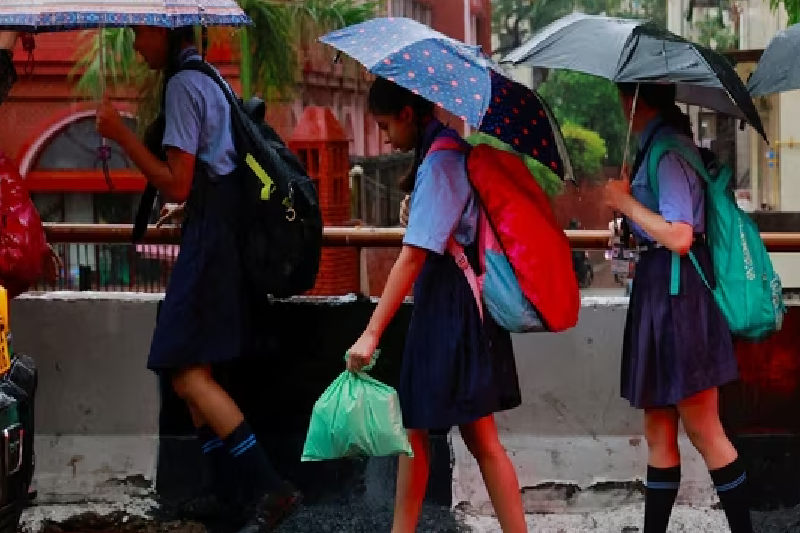
Schools Closed in Rain-Hit Jammu Region Till August 30: Safety Measures and Online Alternatives in Focus
Heavy Rains Disrupt Normal Life Across Jammu Division
The Jammu and Kashmir government has announced the closure of all schools in the Jammu region until August 30, 2025, following continuous and heavy rainfall that has severely disrupted daily life. The torrential downpour has triggered flooding, landslides, and waterlogging in several districts, forcing authorities to prioritize the safety of students, teachers, and school staff above all else.
This marks the third consecutive day of school closures in the region, with both government and private institutions instructed to suspend physical classes until weather conditions improve. The directive was issued by the Director of School Education, Dr. Naseem Javaid Chowdhary, on Thursday, who also stressed the importance of maintaining preparedness for reopening once conditions stabilize.
Online Classes Suggested for Senior Students
In his order, Dr. Chowdhary directed schools to assess the feasibility of conducting online classes, particularly for students of Classes 9 to 12. This suggestion comes in light of the upcoming academic schedules and examinations, ensuring that learning continuity is not entirely hampered despite the shutdown.
However, the decision to shift to online learning depends on the availability of infrastructure and internet connectivity, which remains a challenge in several areas of the Jammu division. Schools have been asked to implement digital solutions only where it is practically possible.
Weather Havoc and Rising Casualties
The heavy rains have caused significant destruction in Jammu over the last two days. The death toll in rain-related incidents has climbed to 45, with the majority of casualties reported from a massive landslide along the Vaishno Devi pilgrimage route. While rainfall eased slightly on Wednesday, the devastation has left behind damaged roads, unsafe slopes, and disrupted access to essential services.
Emergency and relief operations are underway with greater momentum, but the situation continues to remain fragile in low-lying and hilly regions where risks of landslides, mudslides, and shooting stones are still high.
Safety Precautions Before Reopening Schools
The Directorate of School Education has instructed all Chief Education Officers (CEOs) and Heads of Institutions to strictly adhere to the Standard Operating Procedures (SOPs) before resuming physical classes. The directives emphasize:
- Thorough cleaning and sanitation of school premises.
- Structural safety inspections of buildings and classrooms.
- Ensuring safe transport and road accessibility for students and staff.
- Special attention to waterlogged campuses and mud accumulation.
Dr. Chowdhary reiterated that reopening will only be permitted once school environments are safe and conducive for students.
Infrastructure Damage and Restricted Access
One of the major concerns driving the closure is the damage to road infrastructure across Jammu. Several roads have been blocked or eroded, making it unsafe for children and staff to commute. Flooding in low-lying areas has further restricted access, and in mountainous regions, the dangers of falling debris and landslides remain severe.
The education department highlighted that school buildings themselves are currently unfit for physical classes, with many campuses facing waterlogging and mud accumulation. Without adequate cleaning and inspection, resuming offline classes could pose a serious health and safety risk.
Government’s Monitoring and Future Directions
Authorities have assured that the situation is being continuously monitored, and further instructions will be issued depending on evolving weather conditions. The government is keeping close watch on rainfall patterns, road restoration work, and disaster response updates before making any decision about reopening schools beyond August 30.
The priority remains to avoid any risk to children, teachers, or supporting staff, especially in vulnerable zones. The administration has emphasized patience and cooperation from parents, students, and school authorities during this crisis.
Academic Impact and Learning Concerns
With schools closed for several days, concerns are rising about the academic impact on students, particularly those preparing for board exams. The introduction of online classes for senior grades is intended to reduce the disruption, but digital access remains uneven across urban and rural areas.
Education experts suggest that schools in better-connected regions should immediately switch to online platforms to ensure that learning gaps do not widen, while also supporting students from disadvantaged areas through recorded lectures, digital notes, and assignments that can be accessed offline.
Community and Relief Response
Local authorities and disaster relief teams are working on ground to restore normalcy. Rescue teams are clearing blocked roads, evacuating families from flood-affected areas, and providing medical assistance. For schools, this means temporary relief measures must go hand in hand with long-term restoration of infrastructure and safety protocols.
The floods and landslides have once again highlighted the vulnerability of hilly and low-lying regions in Jammu to extreme weather events. The government has acknowledged the urgent need for disaster-resilient school infrastructure and contingency plans to protect educational continuity in the future.
Conclusion
The closure of schools in Jammu till August 30 underlines the severity of the rainfall-induced crisis that has disrupted daily life, education, and travel across the division. With 45 lives lost, roadways damaged, and school campuses rendered unsafe, authorities have rightly prioritized safety.
While the temporary shift to online learning for senior students may offer some relief, the broader challenge lies in restoring safe conditions and minimizing academic loss. Until then, the Jammu education authorities remain firm that no compromise will be made on student safety.
The coming days will be crucial in determining when and how schools reopen, with the administration balancing immediate relief efforts and long-term recovery.



